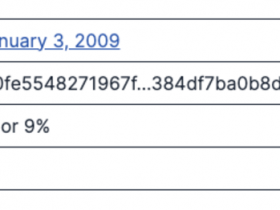

Four years after the start of the COVID-induced global financial crisis, the global economy is at a crucial juncture, characterized by subdued inflation and low unemployment, but overshadowed by uneven growth and escalating debt in advanced economies.
Recent data of the G20 countries paint a complex picture of economic health, raising questions about the long-term viability of the fiat system and Bitcoin’s potential emergence as a financial necessity.
Current global fiat economic status
Inflation rates have generally remained the same stabilized in advanced economies. The eurozone reports inflation at 1.8%, the United States is at 2.5% and the United Kingdom is stable at 2.2%, all close to the central bank’s targets. These figures suggest that effective monetary policy maintains price stability without severely restricting economic activity.
However, stark contrasts exist in emerging markets like Argentina and Turkey, where they are struggling with hyperinflation rates of 237% and 49.38% respectively. Traditional monetary interventions in these countries have struggled to control rising prices, eroding public confidence in fiat currencies.
Global interest rates further illustrate the divergent economic strategies. The United States and the eurozone have cut interest rates to 5% and 3.65% respectively, aiming to boost growth amid signs of slowing economies. Japan continues its long-standing ultra-low interest rate policy of 0.25%. Conversely, Argentina and Turkey have set exorbitantly high rates of 40% and 50% in attempts to rein in inflation, highlighting the limitations of conventional fiscal instruments under extreme conditions.
Economic growth is uneven around the world. The United States is showing robustness GDP growth at 3%, supported by solid consumer spending and investment. Indonesia leads with a remarkable 3.79%, demonstrating the vitality of specific emerging markets. In contrast, Germany and South Korea face slight contractions of -0.1% and -0.2% respectively, indicating potential structural problems and vulnerability to external shocks.
Unemployment rates in advanced economies stay lowwith Japan at 2.5%, the United States at 4.2% and the United Kingdom at 4.1%. These tight labor markets could put upward pressure on wages, potentially reigniting inflation if not managed carefully. Meanwhile, South Africa’s unemployment rate remains worryingly high at 33.5%, and Spain’s at 11.27%, due to persistent structural problems that require comprehensive policy responses.
Critical, levels of government debt raise critical concerns about longer-term fiscal sustainability. Japan’s debt ratio is alarming at 255%, that of the United States is 122% and that of Italy is 135%. While current low interest rates make these debt burdens manageable, any significant economic downturn or increase in borrowing costs could worsen fiscal pressures, undermining confidence in fiat currencies.
The Bitcoin Hyperbitcoinization Timeline
Against this backdrop, the concept of hyperbitcoinization – the point at which Bitcoin becomes the world’s dominant form of money (or value) – is gaining relevance. Quantitatively, the timeline can be imagined in phases:
- Phase 1: Bitcoin remains a speculative asset and a hedge against long-term local economic instability and inflation. Adoption is growing incrementally, driven by individuals and institutions seeking diversification.
- Phase 2: Rising global debt and the declining effectiveness of traditional monetary policy could accelerate Bitcoin adoption. Technological advancements, such as improved scalability and transaction speeds through Layer-2s and meta-layers, in addition to more explicit regulatory frameworks, would enable broader integration.
- Phase 3 Should fiat currencies face systemic crises due to unsustainable debt levels or hyperinflation, Bitcoin could transition from a peripheral asset to a central part of the global financial system, making it essential for maintaining value and conducting transactions.
Current position on the timeline
Analyzing current economic indicators, we are in the early to mid stages of Phase 2. The global fiat system, while functional, is showing signs of stress due to high debt levels and uneven economic performance. Central banks have thus far maintained control over inflation and liquidity, but the ongoing challenges highlight the gradual materialization of conditions conducive to accelerated Bitcoin adoption.
- Hyperinflation in emerging economies: Argentina’s inflation rate of 237% and Turkey’s at 49.38% are seriously undermining confidence in the national currency, causing citizens to look for alternatives such as Bitcoin to maintain their prosperity.
- Exorbitant interest rates: Argentina’s and Turkey’s 40% and 50% interest rates reflect desperate attempts to stabilize economies, often with limited success. These interest rates show the limitations of conventional monetary policy.
- High government debt ratios: The debt levels of 255% of Japan, 122% of the United States and 135% of Italy raise alarm signals about future fiscal sustainability and the potential risks of currency devaluation.
- Unequal GDP growth: While the US and Indonesia are seeing robust growth of 3% and 3.79%, contractions in Germany (-0.1%) and South Korea (-0.2%) indicate vulnerabilities that could have broader implications.
- Technological advances in Bitcoin: Improvements in Bitcoin’s infrastructure such as the Lightning Network increase its viability as a mainstream financial instrument, addressing previous limitations in scalability and transaction speed.
- institutional adoption: Major players like BlackRock are now actively promoting Bitcoin as a crucial part of the global financial infrastructure. Spot Bitcoin ETFs have had one of the most successful launches in the history of exchange-traded products.
- Adoption by nation states: Countries like El Salvador and cities like Lugano have adopted Bitcoin as legal tender. Nations are also testing Bitcoin mining’s ability to manage power grids, discussing Bitcoin as a reserve asset, and assessing the benefits of tokenized digital securities.
Economic disparities, high debt levels, and diminishing returns to traditional monetary policies in certain regions pose increasing challenges to the stability of the global fiat system. While we have not yet reached a point where Bitcoin is a necessary replacement for fiat currency, current trends suggest a gradual shift towards its wider adoption. As economic pressures increase and the technological and regulatory landscape evolves, Bitcoin’s role could transition from an alternative asset to a necessary part of the global financial architecture.
The coming years will be critical in determining whether Bitcoin will move closer to necessity in the hyperbitcoinization timeline. CryptoSlate will continue to monitor economic indicators, policy responses and technological progress to provide a clearer understanding of this potential paradigm shift.







Leave a Reply